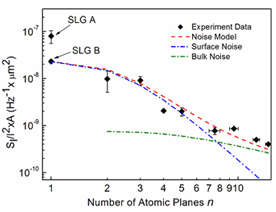
Graphene Sheds Light on the Mystery of 1/f Noise in Electronic Materials

20-Jun-2013
by Alexander Balandin


The low-frequency 1/f noise – fluctuation process with the spectral density inversely proportional to the frequency f– is ubiquitous phenomenon found everywhere from fluctuations of the sea level and intensity in music recordings to human heart rates and electrical currents in materials and devices. The low-frequency fluctuations in electrical current attract a particular attention. The low-frequency electronic 1/f noise was first discovered in vacuum tubes, in 1925, and later observed in a variety of electronic devices. The importance of this noise for electronics motivated numerous studies of its physical origin and methods for its control. For example, the signal’s phase noise in a radar or communication gadget such as smart phone is determined, to a large degree, by the 1/f noise level in the transistors used inside the radar or smart phone.
However, after almost a century of investigations, the origin of 1/f noise in most of material systems still remains a mystery. A question of particular importance for electronics is whether 1/f noise is generated on the surface of electrical conductors or inside their volumes. A team of researchers from the University of California – Riverside (UCR), Rensselaer Polytechnic Institute (RPI) and Ioffe Physical-Technical Institute of The Russian Academy of Sciences was able to shed light on 1/f noise origin using a set of multi-layered graphene samples with the thickness continuously varied from around 15 atomic planes to a single layer of graphene.
The team was led by Dr. Alexander A. Balandin, Professor of Electrical Engineering and Founding Chair of Materials Science and Engineering at UCR [link: http://www.engr.ucr.edu/faculty/ee/balandin.html]. It included Dr. Guanxiong Liu, Research Associate in Professor Balandin’s Nano-Device Laboratory (NDL) [link http://ndl.ee.ucr.edu/index.html], Dr. Michael S. Shur, Patricia W. and C. Sheldon Roberts Professor of Solid State Electronics at RPI and Dr. Sergey Rumyantsev, Research Professor at RPI and Ioffe Institute. The results of research have been published in the Applied Physics Letters under the title “Origin of 1/f Noise in Graphene Multilayers: Surface vs. Volume.”
“The key to this interesting result was that unlike in metal or semiconductor films, the thickness of graphene multilayers can be continuously and uniformly varied all the way down to a single atomic layer of graphene – the ultimate “surface” of the film,” – explained Balandin. “Thus, we were able to accomplish with multilayer graphene films something that researchers could not do with metal films in the last century. We probed the origin of 1/f noise directly.” He added that previous studies could not test metal films to the thicknesses below ~8 nm. In case of graphene the thickness is 0.35 nm and can be increased gradually, one atomic plane at a time.
“Apart from the fundamental science, the reported results are important for continuing the downscaling of conventional electronic devices. Current technology is already at the level when many devices become essentially the surfaces. In this sense, the finding goes beyond graphene field,” – said Balandin. He also noted that the study was essential for the proposed applications of graphene in analog circuits, communications and sensors. This is because all these applications require acceptably low levels of 1/f noise, which contributes to the phase noise of communication systems and limits the sensor sensitivity and selectivity.
News about this FAME research was highlighted by variety of media:
http://www.nanowerk.com/spotlight/spotid=29276.php
http://www.materialstoday.com/view/31025/the-mystery-of-the-1-f-noise/
http://phys.org/news/2013-03-century-old-problem-graphene-professor-low-frequency.html


